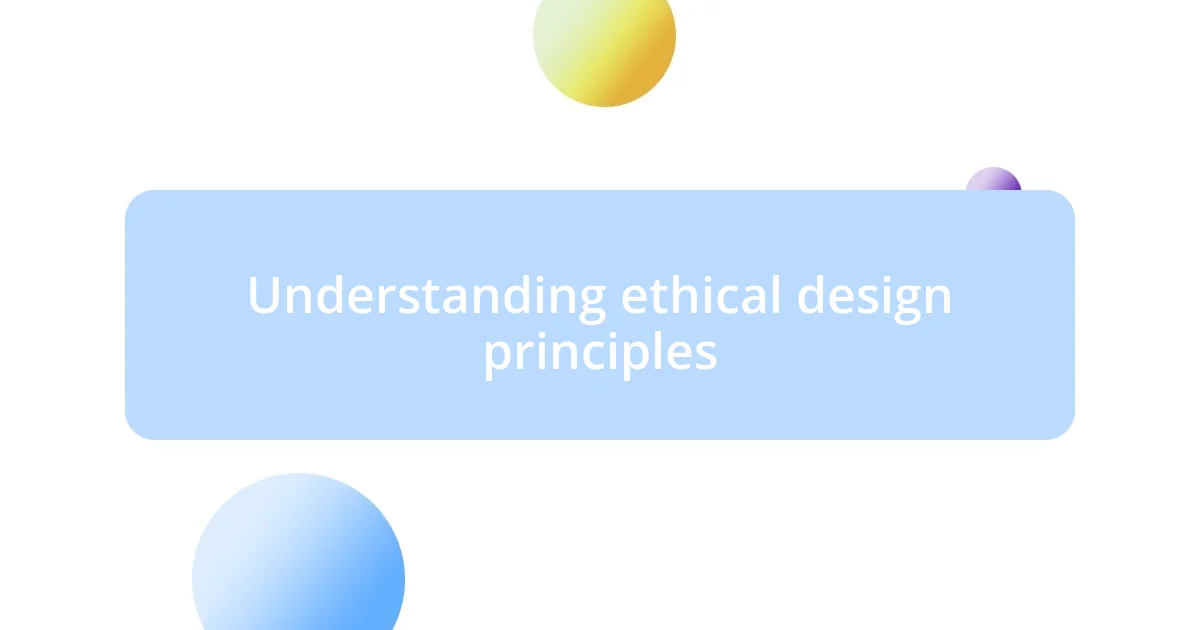Key takeaways:
- Ethical design prioritizes user well-being, transparency, and sustainability, as seen in experiences that reshaped product design and brand trust.
- User-centered design fosters deeper connections and innovation by incorporating user feedback, leading to products that resonate and serve diverse needs.
- Continuous feedback loops between designers and users are essential for ongoing improvements, ensuring that ethical considerations remain central to the design process.

Understanding ethical design principles
Ethical design principles revolve around creating products that prioritize the well-being of users and society. I remember a project where we focused on accessibility; it was eye-opening to see how thoughtful design could genuinely change lives. Have you ever considered how everyday products could be reimagined to include everyone, regardless of their abilities?
When we talk about transparency in design, it’s essential to understand the impact of our choices on user trust. I once worked on a branding project where we openly shared our design process with the audience. The feedback was overwhelmingly positive, as people felt included and respected. Isn’t it fascinating how transparency can foster deeper connections between a brand and its users?
Sustainability is another critical pillar of ethical design. There was a moment in my career where I chose to advocate for eco-friendly materials in a product line, despite the higher cost. Initially, the pushback was substantial, but eventually, the long-term benefits became clear. Don’t you think that our choices today will shape the environment for future generations? This realization often drives me to prioritize ethical considerations in my design work.

Importance of user-centered design
User-centered design stands at the heart of ethical design practices. When I first delved into this approach, I was surprised by how deeply understanding user needs can enhance the design process. I vividly remember a project where feedback from users transformed our initial ideas into something truly groundbreaking. It was an enlightening experience to witness how focusing on users led to a solution that resonated far better than anything we could have imagined on our own.
- Enhances functionality by aligning products with user needs.
- Fosters loyalty, as users feel valued and understood.
- Encourages innovation, as diverse perspectives lead to creative solutions.
The impact of user-centered design extends beyond mere product functionality; it nurtures a sense of community. One time, we held workshops where users shared their experiences directly with the design team. The warmth in the room was palpable as participants voiced their needs and aspirations. It reminded me of the profound connection that can be forged when designers genuinely listen. This is what makes user-centered design not just important, but essential to creating meaningful, lasting products.

Strategies for sustainable design
When I think about sustainable design, I can’t help but reflect on the choices we make regarding materials and processes. One particular project involved switching to biodegradable packaging. The initial resistance from suppliers was daunting, but once we sourced the right partners, it was exhilarating to see everything come together. It made me realize that sometimes, pushing boundaries not only leads to greener solutions but also inspires others in the industry to follow suit.
Another vital strategy is to incorporate energy-efficient practices throughout the design lifecycle. In my own experience, revisiting our manufacturing processes allowed us to significantly reduce waste and energy consumption. For example, implementing a lean manufacturing approach not only minimized excess but also improved product quality. Have you ever witnessed how small adjustments can lead to substantial returns in sustainability efforts? This hands-on experience reaffirms my belief that optimization is a continuous journey, and striking the right balance is crucial for sustainable outcomes.
Collaboration is equally essential in the realm of sustainable design. I recall an initiative where we partnered with local communities to understand their needs better. By involving them in the design process, we not only achieved relevance but positively impacted their environment. It’s remarkable how collaboration can amplify our efforts and foster a sense of shared responsibility. Have you experienced the power of community-driven design?
| Strategy | Description |
|---|---|
| Material Choices | Utilizing eco-friendly materials like biodegradable packaging to reduce environmental impact. |
| Energy Efficiency | Implementing energy-efficient practices to minimize waste during production. |
| Community Engagement | Involving local communities to create products that better serve their needs and promote sustainability. |

Balancing aesthetics with ethics
Balancing aesthetics with ethics is often a tricky dance in design. I vividly remember a project where we had to choose between a sleek, glamorous look and a more sustainable approach that didn’t quite match the initial vision. The team faced a dilemma: could we create something visually appealing while also adhering to ethical standards? Ultimately, we found a way to blend organic textures with a modern aesthetic, proving that beauty doesn’t have to come at the expense of our values.
As I navigated this blend of form and function, I felt an overwhelming sense of responsibility. I’ve seen firsthand how choosing sustainable materials, like recycled plastic, transforms not just the product’s lifecycle but also the emotional connection consumers have with it. When I shared the story about our decision to use these materials with our clients, their eyes lit up with excitement. It was a moment that highlighted how transparent design practices can resonate deeply when aesthetics do align with ethical considerations.
Is it possible to create work that looks good and feels good? I believe it is. For me, combining aesthetics and ethics often leads to unexpected innovations. In one instance, we designed a product that not only looked stunning but also included a QR code linking to the story behind our material choices. This connection allowed users to feel the weight of their purchasing decisions. It was rewarding to witness how bringing the narrative into our design elevated both its appeal and its ethical stance, fostering a more informed consumer base.

Incorporating accessibility in design
Incorporating accessibility in design is a fundamental aspect that should never be overlooked. I once worked on a project where we were tasked with redesigning a website. Initially, I didn’t think much about accessibility, but as I learned more about the needs of users with disabilities, it became clear that our design choices would make a significant difference. Implementing features like alt text for images and ensuring keyboard navigation wasn’t just a requirement; it was a revelation. To me, those small adjustments transformed the website into a space where everyone could engage and interact.
Accessibility goes beyond just meeting compliance standards; it’s about creating inclusive experiences that resonate with all users. I remember a brainstorming session where we explicitly focused on aspects like color contrast and font size. While some team members viewed these adjustments as mere details, I emphasized how they profoundly impact user experience. It was heartening to see how this shift in mindset led to designs that invited rather than excluded. Have you had moments where you realized your design choices could either uplift or alienate users?
For me, every decision in the design process should consider how it affects diverse audiences. One time, we collaborated with an advocacy group for the visually impaired during a product development phase. Their feedback was instrumental; they shared stories about their daily challenges and how certain design features could ease those struggles. I left that meeting inspired, as it was a vivid reminder that design’s true purpose is to serve and empower. We left that session not just with actionable insights, but also with a renewed sense of purpose, knowing that we were contributing to a more accessible world.

Feedback loops in ethical design
Feedback loops are crucial in ethical design, guiding us toward better choices. I vividly recall a project where user feedback revealed unanticipated issues with our design, particularly its environmental impact. It was surprising to see how our users cared about these aspects, ultimately pushing us to revise our approach and embrace even more sustainable practices. Have you ever considered how user feedback can shift your design philosophy?
In my experience, these loops create a dynamic conversation between designers and users, which leads to continuous improvement. I remember a design sprint where we prototyped a product without sufficient user input. Once we started inviting stakeholders to share their perspectives, the insights were eye-opening. It reminded me that design is not just about our vision but about engaging with those who experience our creations.
Establishing feedback loops isn’t just beneficial—it’s essential. I once partnered with a community group to discuss the ethical implications of our work. Their stories and experiences helped us refine our product significantly. It was a powerful reminder that making ethical design choices isn’t a one-time decision; it’s an ongoing journey that evolves through honest dialogue and reflection. Have you engaged with your audience lately to gather their thoughts on your design?














